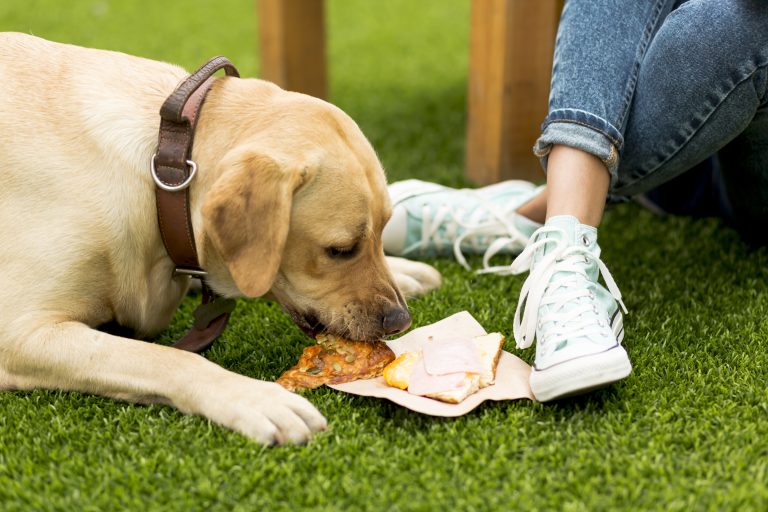The dangers of overfeeding are a real problem that, if not treated in time, can lead to much more serious conditions for your puppy. Most owners do not realize if their dog has weight problems, but canine obesity has become an extremely common problem, as National Geographic writes in its articles.
Fortunately, there are very simple solutions that will help you take care of your dog’s health.
Canine obesity has become a major problem. It is estimated that between 22 and 40 percent of dogs worldwide are obese. The condition often leads to other health problems, including diabetes, kidney dysfunction and respiratory problems.
A dog with an ideal weight should easily identify its ribs, free of fat, by palpation. A dog suffering from weight problems cannot distinguish its waist if viewed from above.
CONTENT:
- What does an obese dog mean?
- The dangers of overfeeding is a real problem that can be treated easily
- Can a dog become obese due to a disease?
- The dangers of overfeeding and it’s causes
- How to treat obesity in dogs: treatment and prevention
What does an obese dog mean?
Most of the time, the ideal weight is judged according to the breed standard. This is not always possible, especially in the case of mestizos. For them, we can use the body weight at the end of the first year of life as a reference.
If the body weight is 5 to 20% more than the ideal weight, this is called overweight. The dog suffers from obesity if it is 20% above its normal weight.
The dangers of overfeeding is a real problem that can be treated easily
Because canine obesity is so common, most people don’t know if they are feeding their dogs too much. The more dogs I see with the same weight, the harder it is to recognize the problem.
Experts recommend that owners talk to veterinarians to determine the best diet for their dogs. If the pet has a weight problem, then the extra pounds must disappear gradually and in a healthy way.
If you see that your dog is suffering from weight problems, a diet rich in fiber and protein will help him lose weight gradually. Of course, to a new diet, you have to add more exercise to see optimal results.
Dogs are usually happy to exercise more. Most of the time, the problem is the owners’ lack of time.
If you are not convinced that your pet has weight problems, consult a veterinarian. The problem is very common and difficult to detect only by the owners. A specialist will also help you choose a suitable diet for your dog, depending on the needs of the breed.
Can a dog become obese due to a disease?
In addition to all environmental and owner-influenced causes, diseases can also be determining factors for an obese dog. So talk to the vet to make sure your four-legged friend isn’t sick.
- Hypothyroidism results in too little production of hormones by the thyroid gland. They are responsible for the function of the cells, and therefore the metabolism of the dog. Due to missing or insufficient hormones, the cells work too slowly and do not use as much energy. In addition, sick dogs often become lazy and do not exercise as much. The dog keeps gaining weight, even if you don’t change the amount of food.
- One of the diseases responsible for obesity in dogs is Cushing’s syndrome (hyperadrenocorticism) – a disease of the cortex of the adrenal gland. In this disease, the adrenal glands produce too much cortisol, which leads to increased appetite and decreased desire for physical activities. These two symptoms cause fat deposits which, due to the disease, are deposited mainly on the abdomen. Dogs with Cushing’s disease have abdominal obesity. These are not ordinary fat dogs, they just have a fat, hanging belly, while the rest of the body is often very lean.
The dangers of overfeeding and it’s causes
The causes of obesity in dogs are many: a sedentary lifestyle and improper nutrition can cause your dog to gain weight and lead to obesity in a very short time.
Sterilization, if not properly controlled in the postoperative course, could endanger considerable weight gain.
The presence of associated diseases, such as diabetes or hypothyroidism, can also cause abnormal weight gain and can take your dog from normal weight to obesity.
How to treat obesity in dogs: treatment and prevention
The importance of a healthy lifestyle starts with food
To prevent and treat obesity, it is important to focus on proper dog nutrition and a healthy lifestyle.
It is advisable to follow a specific and balanced diet, rationalizing the portions throughout the day without exaggerating with larger portions than usual.
We know perfectly well that your faithful friend will have sweet eyes and beg for another ration of food, but you will have to be strong and endure this moment: after all, you are doing it for his good.
You don’t have to give him scraps from the table because your dog is not a human being, he has a metabolism and an organism that reacts differently than yours and, therefore, he needs specific foods.
Running, playing, jumping, walking: these are all activities that you will have to plan daily, even more so if you live alone in an apartment and your dog does not have a garden or a playmate to play with. and spend the days.
If your dog is obese and therefore faces considerable fatigue during exercise, you will have to work together with him: with a little patience, in a few days you will arouse his desire to play again.
If you happen to live near the sea or a lake, in the summer you can also opt for swimming: this discipline is perfect for keeping your weight under control and you will discover that it will be extremely fun for both you and your dog.

